QuestionQUESTION: I have an 8 month old male leopard gecko. I bought him in August 2008 and he has been very skinny from the time I bought him. He eats his crickets, waxworms, meal worms ever so often but i always find some leftover. He is on Reptile carpet and i dust all his food with calcium and give him fresh water. So if you know whats wronge with him please help me.
PS my parents wont let me take him to the vet because the bills are so expensive.
Thank you!
ANSWER: Hi Annie,
The first thing that comes to my mind is...
do you "gut load" the insects before you feed them to your leo? Crickets and mealworms will eat!!!..Do not keep the meal worms in the fridge as they say to do. When you keep them at a cool room temperature, they will eat!! Its important to feed your insects good foods before feeding them to your leo. If the bugs aren't well fed and nutritious, your leo won't get any nutrition from them.
That Gel stuff they sell for crickets is not food. For food, raw potatoes, carrots, salads, green beans, unsweetened cereals, etc are all good for the insects.
My 2nd thought is you aren't providing proper temperatures for your leo and he can't properly digest the foods he eats.
My 3rd thought is that he has internal parasites that need to be checked by a vet so proper medication can be given.
I'm including a basic care sheet so that you can see the correct temperatures, housing, etc that a leo needs. As for the cost of a vet..its part of owning reptiles or any pet. You may have to earn the money around the house to help pay for the vet visit. Also, when the vet knows that its a child that is earning the money for the vet visit, the vet MAY cut a break on the cost to help the child out.
BASIC CARE FOR A LEOPARD GECKO
Leopards are pretty easy to care for but they do need
special care. Here are some of the basic needs of your gecko.
HOUSING: The need to have at least a 20 gallon long tank for one Leo. This needs to have a secure fitting screen top...they can be quite the escape artists!!! They need to have a humid hide box.You can make this with something as simple as a small plastic dish with a hole cut in one side and a small mesh bag filled with some Sphagnum moss coconut bark or Peat moss that you mist.
I made mine out of the small plastic folgers coffee containers...I cut an opening in the lid..and put the moss in..they LOVE it. I use the terrarium moss in mine.
I use that on the warm side of the tank. Be sure to provide a cool hidebox on the other end. I also provide a mid temperature hide...which is in the middle of the tank.I use the critter caves which you can purchase. NOT the ones that have heat in them!!!!
Provide secure climbing areas for your gecko. Fake plants, rocks and branches are all fine to use. be sure there are no wires or sharp ends to any fake plants you use.
*****SUBSTRATE:(that's the stuff on the floor of your tank) Newspaper, lizard carpet or paper towels work great and are easy to clean and are much safer than any loose substrate. Sand or other loose substrate is not recommended as that they can be deadly to the leo when it is ingested(eaten, even by accident while eating their insects)...A very graphic site of an impacted leo surg can be seen at http://homepage.mac.com/exoticdvm/reptile/PhotoAlbum181.html it is very graphic!!! ******What I have found that works great for safety and heat distribution is using about 1/4 inch of childrens play sand(since the tiles fit tight together, there is no sand danger) on the bottom of the tank and on top that you place ceramic or slate floor tile. What is nice is that the 12 x 12 squares fit perfect in a 20 gallon tank with no spaces between the tiles. The sand and the tile distribute the heat wonderfully. Using the under tank heater as described is what distributes the heat. Also,
overhead heat will help in heating the tiles...I've been using this set up for several years and the leos love it. Using a tile that isn't smooth is recommended. **********
TEMPERATURES: They need a warm area of 88-92 degrees and a
cooler area in the upper 70s, low 80s. At night their temperature can drop to the low to mid 70's.
Never use a hot rock for a leopard gecko...or any reptile.
They can severely burn any reptile. You can use a heating
pad under the tank,under tank heater, or you can use a regular household lightbulb in a dome fixture with a ceramic socket in it to keep the warm area at the 88-92 degree area.At night, no white light. If room temperatures stay above 70 degrees, no extra night heat is needed. The undertank heater or heating pad should cover about 1/3 of the tank....be sure to raise the tank up about 1/4-1/2 inch off the stand when using an undertank heat source to prevent heat build up which can cause the glass to break and hot spots in the glass. Be sure to have a good layer of newspaper, carpeting or, even a thin flat rock(such as tile) on top the area that the undertank heat source is placed...if you use a thin rock or tile, it helps to distribute the heat very well.
You can use the special nighttime lights that are designed for reptiles. I like using a ceramic heat emitter on a thermostat for nighttime heat.
DO NOT use black lights or party lights as they can cause eye damage!!!!
The wattage you use will vary based on room temperature and size of tank.
LIGHTING: Leopard geckos do not need UVB lighting but it does not hurt them to give them uvb. They should have some type of light during the day, be it a uvb tube, regular florescent light, reptile day light or regular household lightbulb. NO white lights at night!!!
FEEDING: Geckos should not be fed crickets or other insects that are bigger than the space between their eyes. Generally, hatchlings can be fed more than once a day,juvys can be fed twice a day, adults are fed once daily or every other day, in the early evening. Crickets and other food items such as silk worms, super, and an occasional treat of a wax worm, need to be dusted with a calcium supplement two times a week and also they should have a small dish of calcium in their tank. I use the lid of a milk jug for the little dish of calcium in their tank. For dusting the insects, Use a calcium with no added phosphorus. Insects must be gut loaded(fed) for at least 48 hours prior to feeding your gecko. Remove any uneaten crix or superworms after 15-20 minutes..... Place a piece of cut potato in the tank so that if you have missed any uneaten insects, they will eat the potato instead of nibbling on your gecko!!!
*************You have to be sure to feed your crickets and insects the right foods before feeding them to your gecko. If your crickets/insects are not healthy and well fed, your gecko will not get the nutrition he needs. You can gut load your crickets and insects greens, veggies, cereals or specially designed commercial foods for crickets or the insects you are feeding. ************
Be sure to have a small dish of clean water for your gecko at all times!!
You can offer them some baby food or fruits on occasion ...
Mine will even eat a small piece of watermelon now and then.WATER: always provide a dish of drinking water. If you choose to mist your gecko to drink, its best to not get the tank too wet as that they do not do well with higher humidity. Sometimes its better to take your leo out of their tank to mist them to get them to drink!!!
HANDLING: Some geckos enjoy being held...others prefer not to be handled at all. Be sure to be very gentle when holding your leo and NEVER grab them by the tail! Their tails are extremely fragile and will break.
I do suggest finding a vet that can treat reptiles BEFORE you actually need one!!! To find a vet that is able to care for reptiles:
http://www.anapsid.org/vets
http://www.arav.org/ECOMARAV/timssnet/amm/tnt_mdsearch.cfm
For more information on leopard geckos:
http://www.thegeckospot.com/leocareindex2.html
http://www.drgecko.com
If you have any questions or don't understand something, please let me know.
---------- FOLLOW-UP ----------
QUESTION: Yes, I do gutload the crickets, I use that orange jelly stuff. I also do keep the meal worms in the fridge. But, I have the proper temperatures in his cage. Can you tell me more about Parasites??
Thanks
AnswerHi Annie,
The jelly stuff isn't the best in getting good nutrition for the insects.Its fine for their water supply..but its better to use veggies and grains for their food source.
For your mealworms, I suggest taking a serving size out the day prior to feeding them to your leo and feeding them as I described earlier.
Parasites..meaning worms internally.
All reptiles do have internal parasites. In fact, they do need a certain amount of them to be able to digest their foods. When they (the reptile) becomes stressed,(moving to a new home) or has been in poor living conditions(pet stores in most cases)that parasite load can become too high and they need to be controlled.
Usually(but not always) the leo will have loose poop...
The vet will look at the fecal sample (poop) under a microscope to determine what type of parasite it is and the correct treatment.
Of course there are many other things that can be wrong with your leo and only a vet can diagnose that.
Leos can get tumors, infections, kidney disease, enlarged livers, etc and all need a vet to diagnose and treat.
Be sure to read the care sheet on the humid hide and everything so you can rule out any husbandry issues as to the cause of your leo loosing weight. Also, you don't want to feed too many waxworms as they can cause fatty liver disease. Feed only a few of them on occasion.
Is his tail skinny? Can you send a picture along with a post?
How many insects does he eat? daily? every other day?
Do you see him drinking water?
Do you mist him so he has a chance to lick at the water drops?

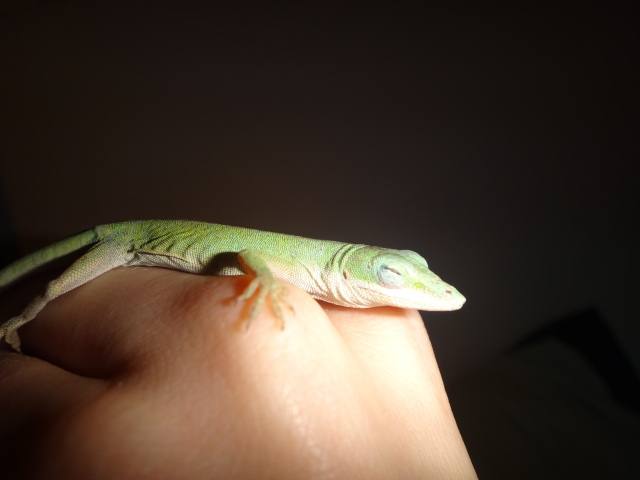 Green Anole with possible eye infection
QuestionQUESTION: I have 5 anoles in a 20 gallon tank w
Green Anole with possible eye infection
QuestionQUESTION: I have 5 anoles in a 20 gallon tank w
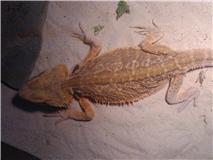 sick
Questionsick lizard
QUESTION: Diane-
I have a t
sick
Questionsick lizard
QUESTION: Diane-
I have a t
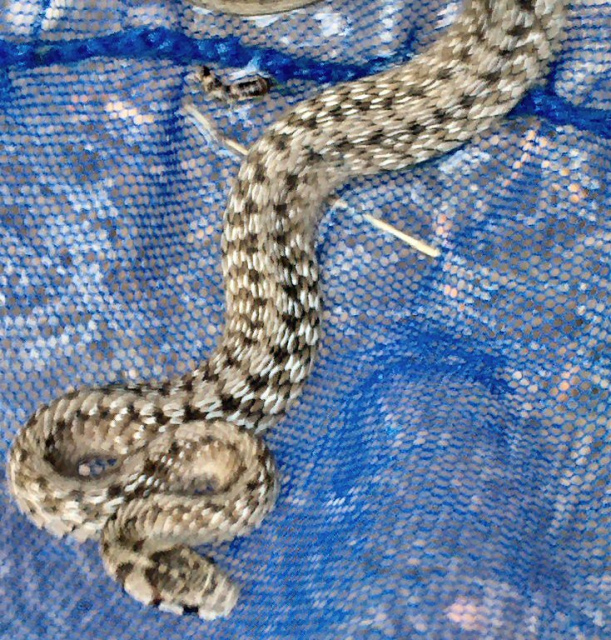 Snake ID please?
Question
Snake!
Hi Donna,
This snake was found in a po
Snake ID please?
Question
Snake!
Hi Donna,
This snake was found in a po
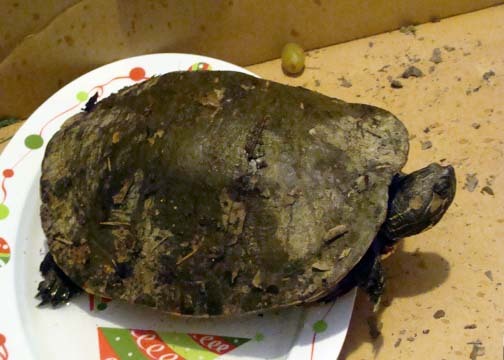 Turtle Identification
Question
Turtle?
Hi,
My kids and I found a large turtl
Turtle Identification
Question
Turtle?
Hi,
My kids and I found a large turtl
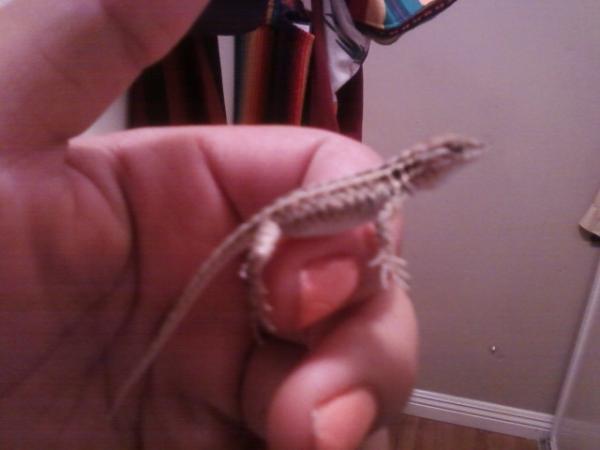 about a baby gecko
Question
the little 1
hi,i really need your help i am w
about a baby gecko
Question
the little 1
hi,i really need your help i am w